|
These were Casio's first fully digital midi keyboards marketed as "Tone Bank". The sound engine was advertised as "CD sound source" (obviously alluding to Compact Disc) and the sample based high resolution PCM timbres contain much reverb and stereo effect that gave them a distinct airy ethereal appeal that was typical for late 1980th.
But the proclaimed high number of preset sounds is deceiving. Despite "210 Sound Tone Bank" or "465 Sound Tone Bank" label, these actually had only about 20 or 30 preset sounds (on individual semi-OBS buttons) of those they only could layer any 2 dual-voice combinations. On some case variants they even printed all combinations on the panel. This was likely result of an arms race with Yamaha, those FM-based Voice Bank keyboards squeezed a huge sound number out of much smaller ROM than possible with samples. So these Casios have fewer individual sounds than later "100 ToneBank" instruments (of those e.g. my CT-840 still can layer any 2 for many more combinations). But the user interface is a bit more flexible (e.g. has another fingered chord mode) than in later models, although vibrato and sustain switch already didn't exist anymore.
That is to say, already the oldest Casio keyboard Casiotone 201 had 29 preset sounds ( = 116 with variation + vibrato switch) and 202 had 49 (in total 392 variants), which relativates the sounds count of ToneBank instruments.
All sounds are made from medium resolution samples; many sound quite natural, others have organ- like timbres but none are really grainy; apparently some oversampling hardware prevents this. The timbre quality is higher and sounds a bit warmer than cheap Casio 100 ToneBank keyboards (like SA-series or MA-130) although their squawky appeal is partly similar and like with these there are many unique and well recognizable sounds (but those 100 ToneBanks sound more extreme). The acoustic "piano" sounds very real and the natural drum kit percussion sounds way clearer and features astonishingly realistic cymbals. There are 2 keyboard effect kit modes for separately playing all the sounds from the "sound effect" patterns (one per key), those include also some wicked tekkno siren noises and space laser sounds those later found their way into SA-series.
All main voice sounds employ a stereo chorus effect and a small dose of reverb (those can not be turned off). Annoying is that many sounds include too long sustain. Don't be confused by the "210 sound tone bank" claim on the front panel; this instrument has only 20 preset sounds (including drum- and effect kit modes) those can be only layered to form 210 dual voice combinations. I do not rate this an actual ToneBank. 10 additional sounds can be reached through MIDI or circuit bending. Unfortunately the accompaniment (during rhythm) accepts only standard establishment chords, although the "fingered 2" mode here at least layers any manual chord notes of "wrong" key combinations with the running accompaniment.
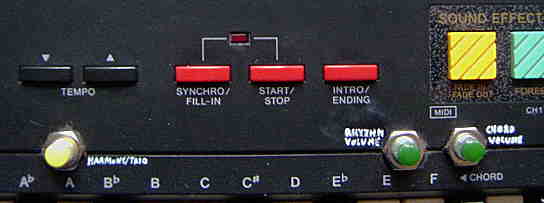 |
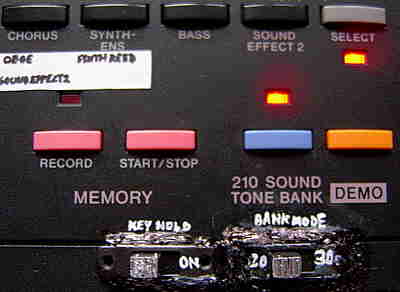 |
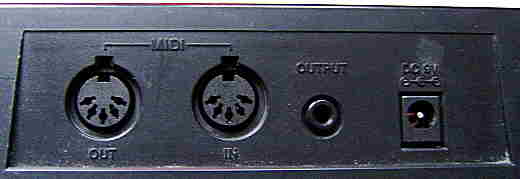 |
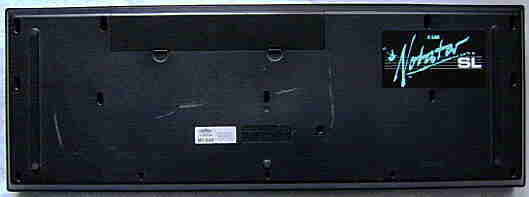 |
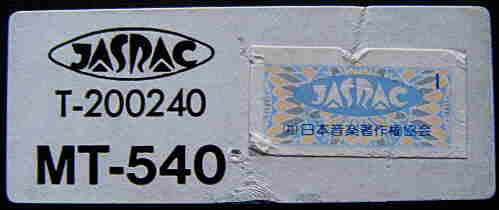 |
All main voice sounds employ a mild stereo chorus effect and a dose of reverb those can not be turned off. There are also neither sustain nor vibrato controls on this instrument and many preset sounds contain annoyingly long sustain. The sounds are genuine stereo (with different panning positions, not just a rotary speaker simulator) and apparently the sound generator employs oversampling because low notes turn duller (like with FM keyboards) and not rough and grainy like with most cheap sample based lo-fi tablehooters. Thus the preset timbres have high tone quality and sound fairly noble although not all of them are realistic. The sampled "piano" sounds astonishingly real and has about 7 split zones (much more than I found on other average home keyboards); you can even well here the woody knocking hammers with higher notes. (Only velocity is missing.) The "harpsichord" rather reminds to a funky clavinet or slap bass in the bass range and like many other timbres here it sounds a bit reedy and of plastic in the mid range, but it still sounds nice. The "funky clavi" is duller and especially has a dull bass range and reminds more to a fuzz distorted lead guitar (also with plastic mids). The "elec piano" has sustain and a slightly squawky timbre (semi- metallic, Rhodes imitation?, also a bit guitar- like with brassy mids); in the bass range a split zone makes it very dull (like a down sampled xylophone?). The "vibraphone" sounds nicely realistic (with 6Hz vibrato); the bass range is quite dull and woody. The "jazz guitar" is more a dull electronic organ timbre with mild tremolo (chorus effect?) decay envelope and dull bass range. The "jazz organ" is a slightly hollow Hammond imitation with percussive attack and mild chorus, while "organ" reminds to a clarinet or wooden pipe organ rank or the "synth reed" found on SA-series keyboards; it has chorus, a dull bass range and slightly longer reverb. The "pipe organ" is a bright metal pipe organ rank timbre, that reminds to the famous multipulse squarewave timbre, but is brighter, has chorus and a duller bass range, which makes it sound more like a transistor organ with a small dose of leslie and sustain; unusual is that volume decreases during the first 0.5s. The "accordion" sounds a bit of plastic in the mids, but otherwise quite natural (with semi- woody bass range). The "brass ens" sounds not at all what the name suggests, but is a thin sounding reedy plastic timbre with strange scratchy attack phase, chorus and a 4Hz vibrato that continues during its fairly long reverb. Possibly it is made from sawtooth waves; it has much similarity with certain thin C64 timbres; especially the (duller) bass range reminds to C64 organ bass sounds. (This sound has nothing to do with the famous SA-series "brass ens" but resembles rather "pop lead" on SA-series or the "magical wind" sound on Casio CZ-230S.) The "strings" fades louder and then quieter during the first second before it holds with fluttering tremolo. The timbre is a little bright and thin and even slightly resembles the bizarre "cello" on Casio CZ-230S although it lacks the drastic timbre change; the trebles have something of a mosquito, and there is a 2s long sustain (which often disturbs). The "flute" has a delayed 4Hz vibrato and while high notes resemble a metal flute, low notes are more like dull woodwinds. The "chorus" attempts to simulate a human choir, but the timbre is more like a dull synth brass chorus with slow attack and fluttering tremolo; the bass range is very dull. The "bells" is a grainy lo-fi timbre of long clanging church bells with a very long echo of repeating clangs (over 10s!); lower notes sound dull and disharmonic. The "synth ens" is a slightly sitar- like bright timbre with decay envelope, 6Hz tremolo and long sustain; the bass range sounds grainy and woody (reminding to some Miracle Piano timbres). The "bass" is a key split sound with a dull e-bass (or nylon guitar?) to the left hand and a funky hammering fat slap bass to the right hand. Great is that when a key is trilled, each new note occupies a new sound channel, which produces a great phasing sound and volume increase effect although this eats up polyphony. Like with many other MIDI keyboards, pressing semi- OBS preset sound buttons with held notes does not affect them in any way but only changes the sound of newly played notes (this can be also used for play tricks, especially with "sound effect" sounds).
"percussion" is a keyboard drum kit mode in stereo that sounds nicely realistic. Most sounds exist in a few different pitches and particularly remarkable are the 15 hifi cymbals and gongs made from loop samples with noticeable tremolo (but no truncated envelope); possibly the reason for the tremolo is that the loop sample plays alternatingly forward and backward to prevent clicks. Some cymbals bend their pitch up or down, which sounds quite unique. There are also 3 synth toms and latin percussion (agogo etc.). The 2 "sound effect" presets are effect kits (like keyboard drum kit modes) with all the samples from the "sound effect" section; many of them have very long sustain (14s), which can be annoying; sustaining sounds can be stopped by switching the accompaniment on or off (no matter if it is running) with the "chord/ midi" switch. Any 2 preset sounds can be layered by selecting one sound, pressing the "210 tone bank" button and selecting the second one.
There are 10 additional preset sounds those are only available through MIDI or circuit bending. The "metallic sound" is a sort of thin distorted lead guitar with halfway sitar- like timbre; it also reminds to a clavinet. "honkytonk piano" is like "piano" with slightly detuned chorus effect. "marimba" sounds like a plain xylophone with quite fast decay and dull bass range; the timbre is more like a short Hammond organ blip (resembling 2 operator FM). The "oboe" has a nicely sonorous woody bass range that resembles more an e-bass or saxophone and decays quieter during the first second. It could be also a semi- brassy pipe organ rank. The "synth reed" is a rock organ with vibrato (about 3Hz), mild chorus and a clarinet- like squarewave- timbre; bass range is duller than normal squarewave. (This sound also exists on Casio SA-series.) The "harp" has a dull bass range and much reverb; the timbre resembles the well known 2 operator FM synth harp sound. "synth celesta" has a bright timbre like a semi- metallic electronic organ chord (resembling Bontempi GT 509 sounds) and a weak echo during key release. "synth clavi" has detuned chorus and sounds like a hifi variant of the bright My Music Center "guitar" timbre, although the bass range is much duller and warmer. The "fantasy" sounds like a sitar and quickly howls up and down again during attack and has a 6s long, slowly pulsing sustain (sounds a bit shorter with longer key presses). The bass range is quite dull. The "miracle" has a slow attack phase and a glassy digitallic synth violin timbre that slowly alternatingly fades bright and duller (like a microphone feedback or bowed glass, a bit sitar- like). The timbre change continues during the 6s long sustain after key release. (A slightly similar "miracle" sound with howling pitch exists on Casio CZ-230S.)
The 8 preset "sound effect" buttons play atmospheric environmental noise
patterns. Normally the sound effect pattern stops 9s after releasing the
button, but when "hold" is pressed, it stays on until "hold" is switched
off again. When "fade in/ fade out" is pressed together with a sound effect
button, the pattern fades louder and stays on. When "fade in/ fade out"
is pressed during the pattern, it fades quieter until silence. The pattern
also stops immediately when when the sound effect volume slider is moved.
The "forest" pattern contains the noise of a brook with bird and cuckoo
voices. "ocean" is ocean waves noise with sea gulls (those whistle rather
flute-like). "street" is car road traffic with honking car horns. "space
wars" has an upward howling bass siren monoto in the background and various
random space laser, explosion and tooting telephone touch tone noises (like
historical videogame sounds). "rainy day" is varying rain noise. "evening"
is cricket chirping, frogs and woodpecker(?) noises. "concert hall" is
varying strong applause with whistling and rhythmically clapping spectators.
"wild western" sounds like galloping horses of varying speed with pistol
shots. All these patterns are not just a boring loop sample (like the infamous
sound effect of those mechanically animated Chinese waterfall picture lamps)
but complex programmed algorithmic sound structures, those vary a lot over
time in semi- random ways and thus sound much more realistic. Another keyboard
with similar atmospheric sound patterns was the Casio
SA-40.
origins in sound sculpturesAs a child I saw on German TV (likely late 1970th, even in a gameshow) an artist who created electronic sound objects of discrete analogue components (freeformed circuit in wall-hanging picture frames, one included a long ferrite antenna coil) those also synthesized natural environmental noises (similar like the "ocean" and "forest" pattern of the Casio MT-540). The ocean one included sea wave noises, wind, gulls and possibly a ship horn. Another was with birds, wind and possibly other animal voices. I first thought of Peter Vogel, but I think I identified the artist as Walter Giers, whose work "Kunst macht Natur" (art makes nature) does simulate such natural sounds with birds, crickets, frogs etc. though a very complicated analogue circuit (seen on Youtube. I read its 2nd channel plays ocean sound.). Companies later made various household relax devices (sometimes with alarm clock) to generate nature sounds digitally, but this art came first and possibly inspired the making of MT-540. |
The 20 preset rhythms are made from the percussion samples, have each an intro, fill-in and ending and also include unusual patterns with latin percussion those partly sound quite oriental; their style is similar like with Casio CZ-230S, although the timbres are clearer, brighter and sound a bit less woody. The semi- OBS preset rhythm buttons wait until the next bar before they switch a running rhythm. The tempo can be adjusted between fairly low and quite high (nothing really extreme).
The accompaniments have nicely unusual patterns, although they partly sound quite cheesy and over- orchestrated. E.g. the "march" has a cheesy flute arpeggio in it. Fortunately the arpeggio (or obligato) track can be muted by selecting the "fingered 2" mode. Many patterns have similarities with the Casio MA-130 styles. Unfortunately the accompaniment (with rhythm) accepts only standard establishment chords, but unusual is that the "fingered 2" mode at least layers any manual chord notes of "wrong" (non- chord) key combinations as additional notes with the running accompaniment. With rhythm off there is a manual chord mode with bass, which fortunately accepts also non- chords; while in "fingered 1" mode the bass sounds with every new note (and additionally as a trio when a standard chord is played), with "fingered 2" only the chord voice plays with individual notes, and the bass sounds only when a standard chord is played. The single finger chord mode sounds always like playing a standard chord. The employed bass and chord sounds in the accompaniments or manual chord modes depend on the currently selected rhythm.
There is also a simple record/ playback sequencer that records any played
notes with accompaniment and sound change events, but it can not be edited.
circuit bending detailsThe hardware of the Casio MT-540 is based on the CPU "NEC D938GD 005" with DAC "Sanyo LC7880", 2 external ROMs (256KB + 512KB) and 8KB SRAM "NEC D4364C-15LL".
The cheaper Casio MT-240 looks almost exactly like the MT-540, but has empty solder holes instead of the 2nd ROM. Its preset sound order is partially changed, which is likely by different ROM (but may be also by some different jumpers or matrix diodes on the control panel PCB.) By installing an EPROM copy of both MT-540 ROMs, it would be likely possible to upgrade the MT-240 (and other keyboards in its hardware class) with the sound effects of the MT-540, however it is not really worth the effort since the real MT-540 is not that rare. The Casio MT-640 (6 orange rubber drum pads, 4 sound effect pads, built-in subwoofer) is based on the same hardware, although the PCB layout (with 2nd amp IC for additional bass speaker) and contents of the 2 ROMs (same types) differ. This sound synthesis engine was referred in a Casio MT-640 prospect as the "CD sound source" (named after the 16-bit sample resolution of Compact Disc??) "based on the latest in 12-bit PCM technology" (despite the ROM contents is actually 16-bit - I dumped it) and it mentions "multi-point sampling technology". The German prospect "Casio hat den Sound" of 1988/89 mentions CD sound source in many related keyboards. The sound generation is apparently based on a highly complex softsynth with many algorithms those can perform PCM, DPCM, FM and TM (triangular wave modulation) synthesis with sophisticated envelopes. The Casio PCM system algorithms are described in the US patent 5319151. This rather confusing 121 page tome however covers plenty of different implementations those e.g. can employ different counts of chip-internal sub-CPU cores for sound generation, which makes it quite ambiguous. I expect that the MT-540 hardware family has at least one of these, while the cheap sounding classic SA-series has none. The interpolation method with that Casio smoothly blends between wavetable sections is described in the US patent 4442745 "Long duration aperiodic musical waveform generator" It plays sections of compacted samples back and forward to implement things like long decaying cymbals. US patent 4958552 explains algorithms how envelope data is extracted from natural instrument recordings and applied on loop samples as a approximated segmented functions. The original envelope may be removed from the stored loop sample by a waveform normalizer (US patent 4691608). Most important is that these chained envelopes can have basically any length and have (unlike e.g. ADSR) no fixed count of steps. Combined with crossfading between adjacent loop samples this permits very flexible sound definition. Triangular wave modulation (US patent 5164530) is an FM-like Casio speciality that generates waveforms by modulating a monotonous carrier function with a sine (or other) wave - decoding the signal by mirroring it at a triangular wave. With the same count of operators (here only 2?) the produced waveform has higher harmonics than normal FM because at high modulation the wave peaks fold back into the opposite direction. Without modulation it outputs a sine wave and so can nicely blend between very dull and bright timbres. The carrier waveform stands in ROM and so can be switched between a variety of timbres. Like with FM, operators can be combined in various ways. The ambient sound effect algorithm (including envelope and sequence patterns) is detailedly described in the EU patent 0322871B1. It employs a lot of envelope tricks to simulate stereo panning, and loops samples (e.g. "brook") on both stereo channels at slightly different frequency to obscure the loop point. Important is particularly that there seem to be no genuinely random based elements involved, but only varying combinations of preprogrammed sequences. keyboard matrixThe control panel is connected through the 20 pin foil cables "JC" and "JB" and the keyboard through the 15 pin cable "JA" those I used here for pin names, because the hair thin CPU pins are not safe to mess with (tend to short by debris). Unfortunately these cable pinouts differ in other keyboards of this hardware class and some pins lack a JC equivalent, thus KI/ KO names were added later by conclusion. Some matrix lines are multiplexed with the 8KB RAM address bus, thus you need matrix diodes to prevent data mess. I later re-sorted the very fragmented table by KO pins (like in service manuals). So I initially kept the "out" numbering in "JC" order. (JC7 is no matrix output and hence skipped. KO7 has no equivalent.) Although at that time I had only the service manual of MT-240 variants (DM-100, Hohner PSK-50) and it turned out that the real thing from MT-540 is sorted the same.This keyboard matrix was analyzed by myself and later verified by service
manuals of Casio MT-540, CT-660.
All unknown function names and in/ out numbers in this chart were chosen
by me. The input lines are active- high, i.e. react on +Vs. Any functions
can be triggered by a non- locking switch in series to a diode from one
"out" to one "in" pin. Only "sustain pedal" needs a locking switch.
But this is only half of the trick, because when used normally, you will only get 5 additional sounds because these new inputs ignore the "select" button (even the "select" LED unlights by pressing these buttons until you switch back to a normal preset sound). Possibly Casio planned here to release also a 25 preset sounds variant of this instrument, although I never saw any of these. To get the 30 sounds mode, a diode has to be connected at JC6->JB13 during power-on reset; when added or removed later, the CPU simply ignores it. But when enabled, the preset sounds are in different order and thus don't correspond to the control panel writing anymore. Instead of adding a fixed diode, for experimentation I wired it through the 2nd channel of that (2 channel) alternating switch, thus the 30 sounds mode is now only enabled when I switch it on during power-on, while otherwise everything stays normal. (The CPU ignores the diode when the switch is set later, thus here the switch still enables the 5 sounds from the 25 sounds mode.) 20 sounds mode: (5 additional sounds)
The rows "select 1, bank 1" and "select 2, bank 1" correspond to the default preset button assignment of the unmodified Casio MT-540. The orange marked sounds are the 5 additional presets. The blue marked inputs apparently step an internal sound "select" register 1 step forward, i.e. when with active "bank 2" switch any blue marked button is pressed and the upper "select" LED was lit (i.e. select=1), then it advances to the lower LED (i.e. select=2), when the lower LED was lit, then both unlight (select=3), and when both are unlit (select is already =3) they stay this way. I don't know if this behaviour is a bug, or if it was intended for something technical. 30 sounds mode: (10 additional sounds)
The orange marked sounds are the 10 additional presets.
The additional LEDs for "registration" and "auto harmonize" from CPU pin KO4 to KO8 need to be demultiplexed through a latch 74HC174 clocked by pin KO1.
The panel LEDs are latched through a 74HC174 from CPU pins KO4..KO9 during a pulse on KO0, and the additional registration LEDs of CT-660 during a pulse on KO1. The "tone bank" LED has a transistor at KO3 and "hold" at KO2. The MT-240 key matrix layout is generally the same but with different preset sound order and of course no effect pads. (I didn't analyze its matrix by myself, but concluded this from service manuals of DM-100 and Hohner PSK-50.) Also the MT-640 key matrix is quite similar but has some changes. So the KO13 line controls 6 drum pads instead of higher note keys, and instead of the effect pads {forest, ocean, street, space wars} there are {quijada, voice, wind chime, orchestra hit}. Also the preset sounds of KO17 differ. external tempo control CPU pin 13 MOSI, 14 MOSO is a 4MHz rhythm clock input (seen in DM-100 service manual), thus connecting an external oscillator to MOSI may permit finer tempo control over a wider range. (I haven't tried this.) ROM hacking?The MT-540 contains 2 16bit ROMs with pinout like 27C400. The main ROM is "NEC D23C2000AC-1 501" (256KB), and the "HN62404P G93" (512KB) is for effects and piano samples. (Parts list of MT-540 and CT-660 service manual have "HN62404PZ15".) All important pins are wired parallel except A17. At the HN62404P also the BYTE pin 31 (the other ROM lacks it) is wired to +5V to prevent 8-bit mode. Despite both pinouts are like an eprom 27C400, the HN62404P contains here a little trick that makes it appear empty (all #FF) when read in an eprommer, namely the OE/ pin is inverted and thus needs +5V instead of 0V to output data. (In an adapter I bent it away and connected it with Vdd to do this.) Likely this was done to simplify multiplexing by toggling between both roms through the OE/ line (but it also might have been a stupid copy protection attempt). With HN62404P removed, the MT-540 still boots properly, but lacks the piano and effect sounds (there are also some popping glitch noises), which shows that the operating system and most samples are in the smaller 2nd ROM D23C2000AC-1 (without that it can not run at all). I later verified this in MT-540 service manual. I compared a Casio CSM-1 rom dump with my MT-540 roms and they are identical.In opposite to this, the Casio MT-240 contains a "HN62404P D27" as its only ROM (can not run when removed), and the OE/ pin of this one behaves normal (not inverted). The same ROM was also used for the lower keyboard of Casio DM-100 and in Hohner PSK50 (seen in service manual). Hohner PSK55 (seen in schematics) has a "HN62404P H84" instead, which I also found on apparent Casio CT-420 scrap PCBs, which only difference is likely the demo song "Ballade Pour Adeline". (According to parts list in service manuals, the 3 lower digits of ROMs are the software number.) Although I haven't done this, I think it may be possible to upgrade the MT-240 (and related keyboards) with MT-540 sounds. For this you would need to copy both MT-540 ROMs on each a 27C400 eprom. Desolder the MT-240 ROM and install a 40 pin DIL IC sockets in its place and another one in the 2 unlabelled hole rows next to it. Install 2 short wire bridges in the empty hole pairs between both sockets and above the empty one. A little complicated is that you need to cut the OE/ line to pin 12 of the HN62404P socket and invert it (using a CMOS inverter IC or transistor). Connect the inverted OE/ to pin 12 of the HN62404P socket and the uninverted OE/ to pin 12 of the unlabelled socket. The eprom with the contents of the MT-540 HN62404P (software number G93) is inserted instead of the old HN62404P, and the eprom with D23C2000AC-1 content into the unlabelled socket (both facing to the same direction, i.e. notch facing at PCB rim). And of course you need to add the missing effect pads and switches to the keyboard matrix. If you want to keep also the old behaviour, you may additionally solder the original HN62404P piggyback onto the new eprom in its place (wire its /OE line uninverted). Disconnect the /CE input (pin 10) and install a switch that connects either the upper (old) or the 2 lower (new) ROMs with the /CE output of the CPU. Add a pullup resistor (about 10 kOhm?) against +5V at both banks to disable the unused bank. (Flip the switch with the keyboard powered off, else it may crash, which may be suited for shitshot.) A mechanically simpler variant to avoid the piggyback soldering would be to use a larger capacity eprom (27C800?) with 42 pins (lower pins are the same pinout) and burn additionally the content of the old ROM into the upper half. Connect the switch output at the A18 address line to switch between both banks. It may even be possible to use only a single eprom with enough capacity (27C160) by burning the D23C2000AC-1 contents into an additional bank and connecting /OE only(?) to A19 to simulate the multiplexing. But this is all theory; I haven't done any of these and can not promise that it works. Many of these mods may also function with Casio MT-640. According to its manual it e.g. has 10 additional preset sounds through MIDI, those likely also exist as matrix eastereggs. Its 2 ROMs are "NEC D23C2000AC-1 503" and "HN62404P Z29", those might be also addable as a bank switch mod fot MT-240. The rom select logic levels of CPU pins 96 and 100 differ between MT-540 and MT-640 (seen in service manuals). pin 96 AR18: MT-540: rom chip enable /CE | MT-640: rom select (hi=rom
1, lo=rom2)
I haven't tested this, so I don't know if e.g. the different software numbers of the D938GD CPUs may prevent it. pinout LC7880The "Sanyo LC7880" (20 pin DIL) is a 16-bit stereo DAC used in various fully digital Casio instrument with high sound quality. This documented IC (Japanese datasheet "Sanyo LC7880, 7880M") receives multiplexed serial data for left & right audio channel. For each channel it internally combines the outputs of 3 types of DAC. The audio needs to be filtered through an external LPF.upper 8 bits (D15..D8): R-string DAC
This pinout is based on the datasheet and service manuals of Casio CT-660
and MT-540.
Pin 14 selects the serial data bit order (lo = LSB first, hi = MSB first). Pin 6 selects the output channel (lo=CH2, hi = CH1). Data is synched at rising edge of pin 9 and stored in SIPO register. At falling edge of pin 7 it is latched to the selected audio channel. pinout D938GDThe "NEC D938GD xxx" CPU (120 pin SMD, pins count counterclockwise, xxx = software number of internal ROM) was Casio's first keyboard CPU using fully digital sound envelope processing and mixing. They named it "CD sound source". All volume controls of individual sound channels (rhythm, accompaniment etc.) are digital. The digital audio {melody, chord, bass, percussion} is output as multiplexed serial data for left & right channel (MSB first) to an external 16 bit stereo DAC (Sanyo LC7880). (The bass amp in MT-640 has no separate channel, but simply extracts the bass through an analogue lowpass filter.) The external RAM "NEC D4364C" seems to be optional (only used for sequencer) because Casio DM-100 lacks it. Sequencer RAM and LED lines are multiplexed with the keyboard matrix. The CPU has 3 ADC inputs for reading analogue signals (AFAIK not used anywhere).The CPU needs an external 16bit ROM for wavetable samples and data. Despite this it also has also internal ROM, which seems to contain things like basic key matrix and user interface behaviour (those stay present even with external ROM removed). This pinout was based on the service manuals of Casio MT-540, MT-640, CT-660, DM-100 and Hohner PSK50. My MT-540 and MT-640 have D938GD software number "005", my MT-240 has
"002". Also Hohner PSK-55 (aka Casio CT-650) schematics shows
"005", which I also found on apparent CT-420 scrap PCBs (IC and
PCB label). The service manuals of Casio MT-540, CT-660,
DM-100
and
Hohner PSK50 mention "001" and of MT-640 mentions "002" and
in block schematics "002 (005)".
But these all may be unimportant minor revision numbers or even specify
electrical properties like the minimum operating voltage (runs on +5.7V
in MT-640, +5.9V in others), because the sounds are in external ROM and
keyboard matrix layouts very similar. So the exact version doesn't seem
to matter.
The Casio MT-750 has a very similar CPU "NEC D937GD 003". It supports a 3 digit LED display and pitchbend wheel (fed into all 3 'Vin' lines shorted together). The MT-750 has 220 preset sounds (some resembling SA-series) stored in an 1MB ROM. Unlike MT-540 variants, the ROM content is scrambled by swapped address lines. It is unknown whether Casio did this as a crude copy protection or to simplify PCB layout. A successor was the "NEC D939GD 010" (160 pin SMD, 20 MHz, "IXA Sound Source" synthesis engine) found in Casio CTK-1000 from 1993, which how ever interfaces velocity sensitive keys and parts of the control panel through 2 external large ICs and uses most of its 160 pins to access SRAM, DRAM and 2MB ROM simultaneously (no shared bus) to increase throughput per clock cycle. |
Fullsize variants of the MT-540 with 30 preset sounds (so-called "465 Sound Tone Bank") and trio mode were released as Casio CT-440/ CT-460 (49 keys, aka Hohner PSK30 in white) and CT-660/ PMP-500 (61 keys). A keyboardless MIDI sound module with MT-540 sound set (including all effects and even the demo, but like all these keyboards without velocity) was released as Casio CSM-1 (aka Hohner MSE-1).
This keyboard was also released as Realistic Concertmate-1000M and Hohner PSK10.
no sound effect pads & -volume slider 2 additional preset sounds {synth reed, metallic sound} (instead of "sound effect" button) different order of semi- OBS preset sounds {piano, harpsichord, vibraphone, jazz organ, pipe organ, brass ens, flute, chorus, bells, (multi-split) percussion | elec piano, funky clavi, jazz guitar, organ, accordion, strings, synth reed, metallic sound, synth-ens, bass} only 1 ROM "HN62404P D27, 8D1" (40 pin DIL, pinout 27C400, 512KB) CPU= "NEC D938GD 002, 8816PK022, Japan" (120 pin SMD) demo lacks effect sounds battery compartment for 6 AA instead of C cells
 |
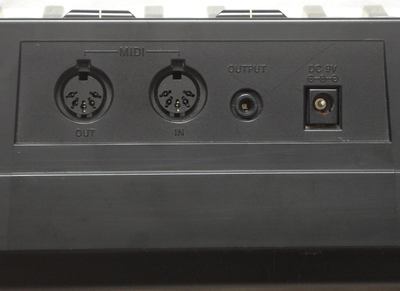 |
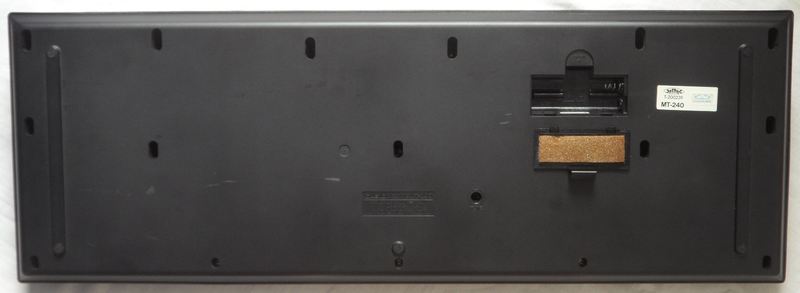 |
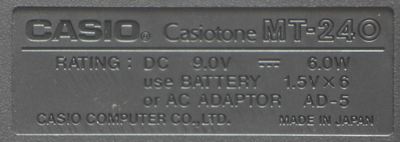 |
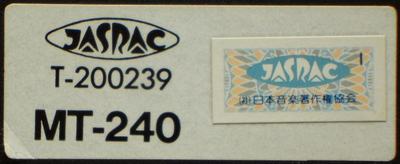 |
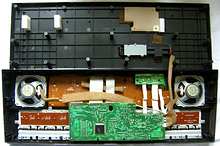 |
 |
The same CPU and ROM like MT-240 was used in the lower keyboard of Casio DM-100 (the likely world-only dual-midsize-keyboard instrument, seen in service manual). Other MT-240 variants with 10 preset sound buttons (210 tone bank) were released as Casio MT-260 (aka Hohner PSK15 in white, large "Tone Bank" list), Casio MT-140 (aka Realistic Concertmate 750, mono). Also the lower keyboard of the Casio DM-100 had this sound hardware (no MIDI, upper keyboard resembles Casio SK-8 main voice). Fullsize variants were apparently the CT-370/ CT-380 (49 keys, mono, no MIDI), CT-607/ CT-615 (61 keys, mono, no MIDI) and with 15 preset sound buttons the CT-640 (61 keys, 465 tone bank, aka Hohner PSK50 in white). These have no preset sound "sound effect" 1..2 and the rightmost 4 semi- OBS sound buttons are {flute, chorus, bells, percussion | synth-reed, metallic sound, synth ens, bass} (seen on Casio CT-370). Another 210 tone bank variant may be CT-420 (49 keys, demo "Ballade Pour Adeline", aka Hohner PSK35 in white with black "Tone Bank" list) and its mono version CT-390 (aka Hohner PSK25 in white). Likely an MT-240 with 61 midsize keys, 15 preset sound buttons (465 tone bank list) and different ROM was released as Casio MT-740 and fullsize as CT-650 (aka Hohner PSK55, white, different ROM seen in schematics). Likely a variant of this was CT-636/ CT-638 (rounded case, only 3 switches).
attention: When a Casio keyboard has a "210 Sound Tone Bank" or "465 Sound Tone Bank" label, then it generally seems to have only 20 or 30 preset sounds (of those only any 2 can be layered to form that many dual voice combinations) and thus has genuinely fewer individual preset sounds than the later "100 ToneBank" instruments (of those e.g. my CT-840 still can layer any 2 sounds to form even many more combinations). But at least non- professional 100 ToneBank keyboards seem to have a lower sample resolution. So 210 or 465 sound tone bank keyboards with huge sound combination list on control panel (e.g. MT-740) are likely just fancy case variants with the same sound engine, that only layers 2 preset sounds. Despite different ROM software number, the only change was likely the demo; e.g. CT-650 and CT-420 has a not too great rendition of the classical piano piece "Ballade Pour Adeline" (seen on YouTube) that became famous by Richard Clayderman, who appeared on various cheesy "Casio Keyboard Lesson" VHS tapes. At least the Casio "220 Sound Tone Bank" keyboards (e.g. MT-750) are genuine again.
 |
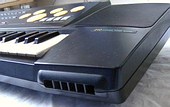 |
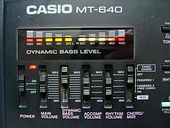 |
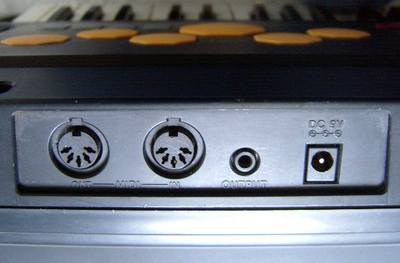 |
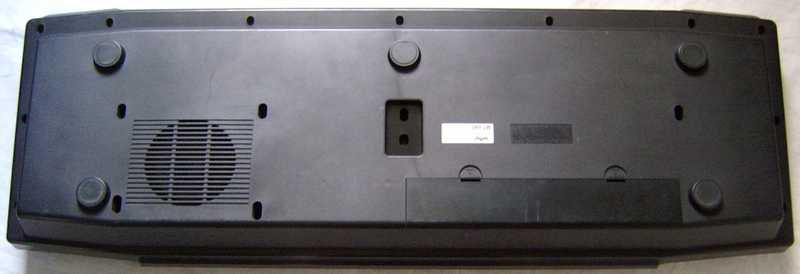 |
 |
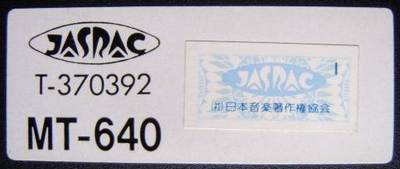 |
hardware detailsThe Casio MT-640 is based on the CPU "NEC D938GD 005" DAC "Sanyo LC7880", 2 external ROMs (256KB + 512KB) and 8KB SRAM "Mitsubishi M68400P-12L" (PCB label "uPD4364C-12L.15L).
keyboard matrixThis keyboard matrix is based on the MT-640 service manual and wasn't analyzed by me. (The 5 additional keys and sustain pedal are mentioned there.) So there may be still unknown eastereggs.
The input lines are active- high, i.e. react on +Vs. Any functions can
be triggered by a non- locking switch in series to a diode from one "out"
to one "in" pin. Only "key hold" needs a locking switch.
The panel LEDs are latched through a 74HC174 from CPU pins KO4..KO9 during a pulse on KO0. The "tone bank" LED has a transistor at KO3. |
Successor of this hardware class were real 220 ToneBank keyboards like
Casio
MT-750.
| removal of these screws voids warranty... | ||
 |
||
|
|